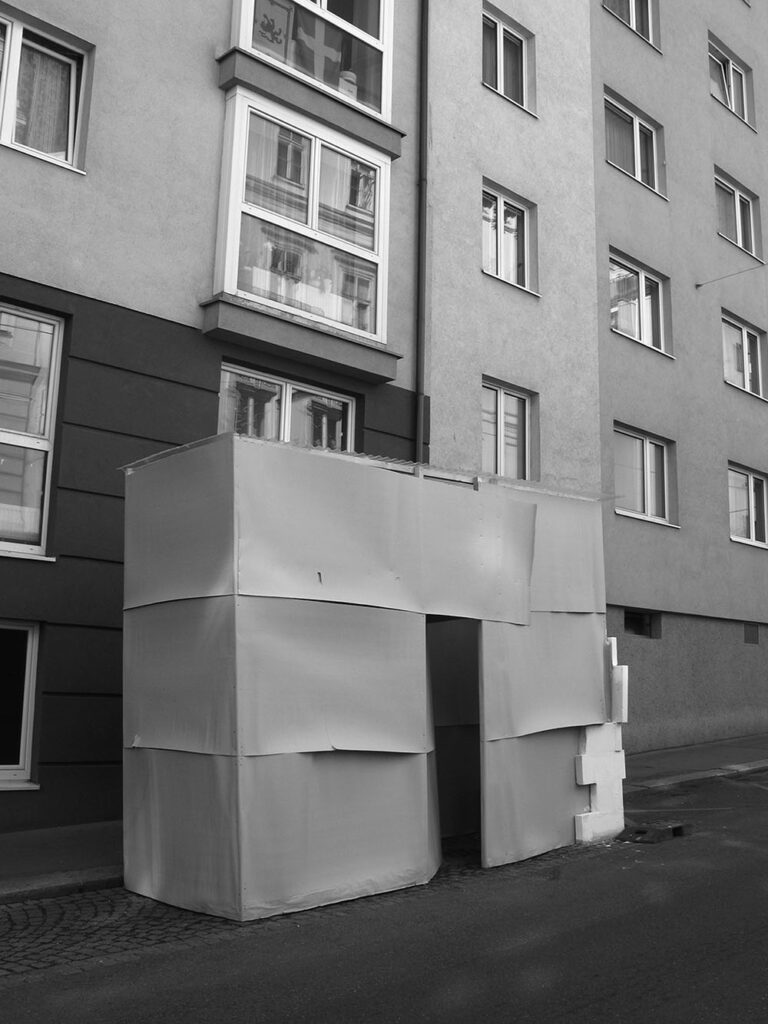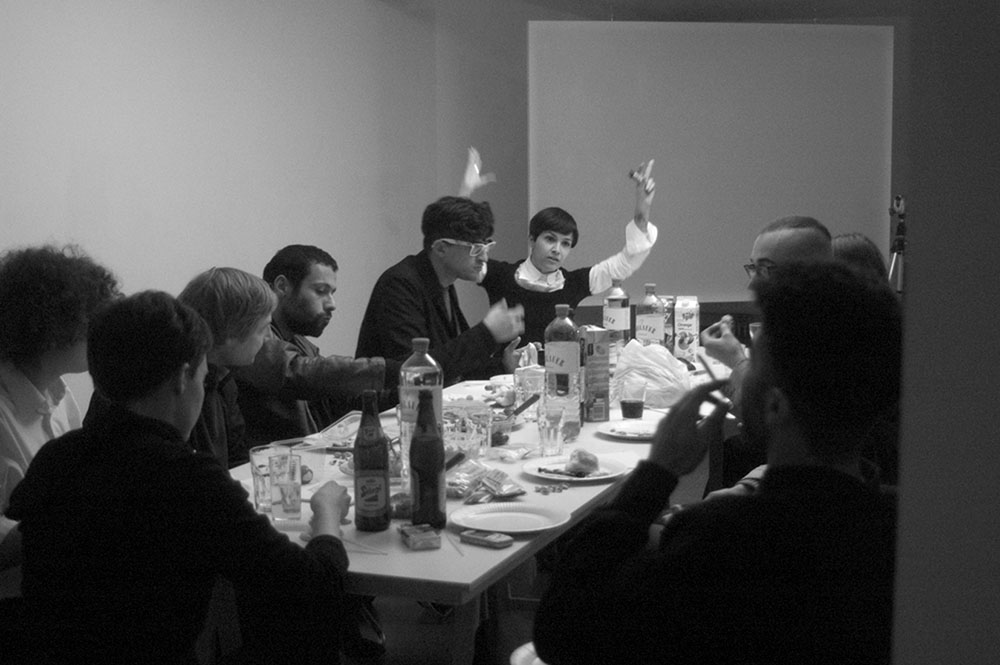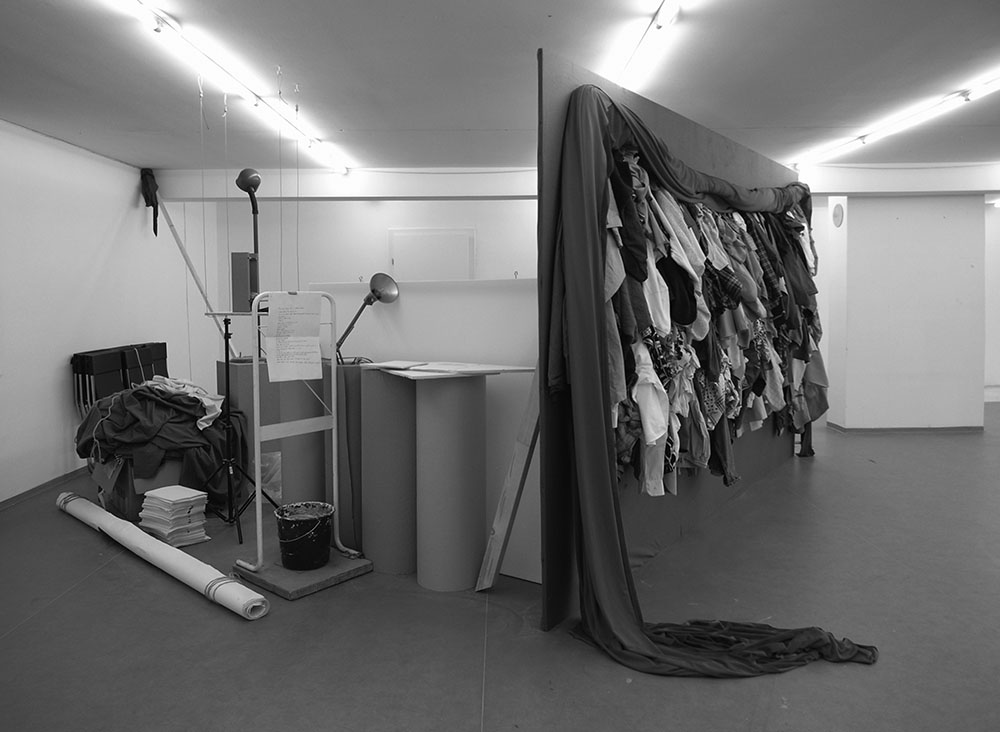Gesprächsrunde / Sakrophyt / Version 2
Linda Klösel
I find the conceptual approach for Saprophyt very interesting, because the art object is deprived of decisive projection surfaces. What remains of a presentation in the space can be reintroduced into the production cycle as material for the next one and recontextualized. Practically nothing is left that can be permanently imbued with meaning or value, and nothing can really be possessed. What remains as a substrate is essentially the artistic process itself. What’s especially intriguing is the decoupling of the artwork from the individual artist. In fact, each presentation involved an ever-growing number of authors—a steadily increasing accumulation of thoughts and actions, from which no single person can easily step into the foreground. Creating the presentation on-site certainly posed a special challenge, one that required questioning one’s own role and self-conception as an artist.
Barbara Kapusta
There was a lot of discussion about how Saprophyt, as a concept and curatorial framework, relates to each artist’s independent practice. The concept clearly shaped how work was done in the space and what kinds of pieces could be created. Saprophyt became a place for installative and ephemeral practices. I think of the wall paintings by Jenni Tischer and Johanna Unzueta, the outdoor sculpture by Octavian Trauttmansdorff, or the architectural interventions by Roberta Lima and Noële Ody. But even such practices remain tied to individuals and inevitably generate value and meaning. I even found that most of the artists countered the saprophyte concept well and then came strongly to the fore as individuals. I wonder whether shared practices might lead to more direct reflection or critique of the value of artistic objects and authorship than ephemeral or spatial interventions do. I’m thinking, for example, of collaborative filmmaking, shared authorship, or openly disclosed divisions of labor. One example that comes to mind is the film Hundekreis, a project by Katharina Aigner, Franziska Aigner, Mathias Windelberg, Astrid Wagner, and Robert Müller. They each come from different disciplines—film and video, sculpture, and performance.
Stephan Lugbauer
Since you mentioned film: I think Saprophyt can be compared well with the dispositive in cinematographic installations, where a relational network of individual elements gives rise to what Homi K. Bhabha calls a “Third Space.” As a medium, the Third Space represents an in-between site of transformation, reflection, and articulation. In this sense, Saprophyt could also be understood as a performative concept, in which translation processes are continuously regenerated through the negotiation of difference.
Miriam Kathrein
I have to respond with a reference to a theorist—Hannah Arendt. She also speaks of in-between spaces, the inter-est, what lies in between, something that establishes relations between acting persons. She says that “what ultimately remains in the world from action is not the impulses that set him in motion, but the stories he produces; only these can be retold again and again and objectified in all kinds of materials.”. For me, that perfectly describes what Saprophyt does: it creates a space in which what remains from action, from doing— artistic activity, exhibiting, artistic and curatorial practice —becomes a story that can be taken up, extended, used as material. These stories can be discovered, read, and retold by both the participating artists and the audience through the works and the space itself. That means the focus is not on the mere production of objects or artworks, but on a processual practice, on creating situations, on mutual exchange, and on the spaces that emerge in the process—spaces that go beyond an architectural setup. And for me, inter-est refers not only to the acting individuals, but to the entire network that makes up Saprophyt—or rather, that Saprophyt as a structure itself makes possible.
Maaike Lauwaert
As I’ve been thinking about Saprophyt over the past few days—a space where experiences, things, and ideas accumulate and form something like geological layers—two things came to mind, for reasons I can’t quite explain. The first came up while I was having coffee with Miriam. There was a green parrot printed on the sugar packet, with the French word “La Perruche” beside it. It reminded me of “La Perruque”, a metaphor used by French philosopher Michel de Certeau in his Theorie des Handelns. Spontaneous associations like that often trigger my thoughts. De Certeau introduces this term for the moments in which we cover one period of time with another—for example, writing a love letter during work hours. Or, more recently, scrolling through Facebook at the office or jotting down notes while cooking. We steal these moments to do something else. Small islands of this “stolen time” are smuggled into the official time corset. The methodology behind Saprophyt reminds me a little of this smuggling. Things are hidden within other things, with traces of what came before still partially visible. The idea of Saprophyt as an institution seems to be about a kind of masking, smuggling, or concealing. Within a dominant structure and its way of functioning, we discover an island of “stolen time” where different rules apply and the usual functions are temporarily suspended.
The second thing that came to mind was the Surrealist method of Cadavre Exquis, in which people collectively write poems or make drawings without knowing what the others have done before them. Like automatic writing, the Surrealists used it to activate the unconscious. Why did this come to mind? Because, just like in Cadavre Exquis, Saprophyt involves participants who relate to and rely on one another. The artists work together without knowing what the final result will be. It is a game with the unexpected, with surprise and the simultaneous knowledge that there is a supporting structure. The beauty of this method lies precisely in that balance between the known and the unknown. It allows the artists to be part of something without needing a fixed end result on site. And in this format, openness can lead to something entirely new—becoming more than just open.
Barbara Kapusta
Maaike’s comparisons and the idea of the in-between space, as brought up by Miriam and Stephan, really resonate. Saprophyt was, above all, an experiment and an organic movement. Those moments when material undergoes transformation and reappears in a new configuration are precisely the moments that raise so many questions. I think of the gray molton fabric brought into the space by Jenni Tischer, which later appeared in various other works. Or Sonia Leimer’s glass panels, which turned up again in the works of Christian Egger and later Neïl Beloufa. The importance of the genuine materials relevant to their own practice suddenly seemed to fade somewhat into the background. We made the ongoing discourse about spatial transformation public through an online continuum—as if language itself could reveal the history of these changes. At the same time, Saprophyt was designed to let things grow into each other. I recently spent some time in front of two display cases documenting Sturtevant’s practice. What struck me was a catalog for a group show in which any record of her work was missing. I found this absence compelling—the fact that something remained undocumented and can now only be partially reconstructed, perhaps just through the stories of other artists or the audience. I realized how much I appreciate such moments. Not everything is accessible—you have to go searching. And when you discover something, it’s thrilling.
Axel Stockburger
To me, Saprophyt primarily represents a shift in focus—away from the finished product and the intertwined product logic, and toward a network of diverse processes that revolve around the exchange of language and material between individuals. I appreciate Barbara’s interest in how, despite the deliberately created traces via the website and publication, many of the details of these transactions are no longer fully retrievable. That there’s a kind of surplus—something that remains only in the memory of those involved, fading into the shadows of the events. This becomes all the more significant given the expansion of the artistic field into countless islands of events that now compete in the ocean of the attention economy to create messages that are as opaque as possible. Running an art space increasingly turns into a branding exercise—one that is primarily about differentiating and promoting the personal brand of its curators or operators. Saprophyt has consciously opposed such logics conceptually by taking the in-between of the different working methods as a starting point. Another key aspect for me is the focus on transformation—already present in the image of the fungus (saprophyte) itself. Spores have the property of distributing themselves in space according to the principles of randomness and combining with the most diverse forms of matter. Similarly, the simple rule of reusing materials within a limited space has repeatedly led to such transformative interpenetrations over the entire period of the project, thus overcoming media boundaries and preconceived artistic approaches. For my personal contribution, it was important to me to carry the resulting “information spores” into other spaces in the form of a poster series and thus introduce a further vibration into the chain of processes. At the same time, I could not ignore the question of how media-related historicization tendencies increasingly reduce artistic events and projects to the proper names of those involved. How can we create meaning collectively while remaining conscious of the constant pressure to produce, finish, package and transport?
Manfred Grübl
Reading the statements, one notices that the emphasis is consistently placed on the processual aspect of artistic practice. The process is always a central component and crucial to the outcome. Especially when I have to engage with a space, I incorporate what is already there into my work. But where and how does this process manifest? The continued working on existing elements, the reuse of materials, or the breaking open of predetermined structures are essential parameters of artistic approaches. Every process encounters friction with natural limitations or defined constraints. What seems essential to me in Saprophyt’s concept is the idea that an artwork itself becomes material for other artists again. It raises the question of whether and how each artist engages with the work of their predecessors, and it becomes clear that the setting itself is already an artistic work. How do the two of you see your positions in your roles as artists or exhibition makers?
Stephan Lugbauer
In this case, it’s not really possible to differentiate between artist and exhibition maker – both roles benefit from and depend on one another. A key part of our practice during that time was engaging with the methods and formats of exhibition making. Through Saprophyt, we were also able to create opportunities for other artists, and that was important – to take on a social function. Our roles oscillated from cleaning and set-up staff to coaches, curators and directors. I believe that good curatorial projects always imply artistic thinking and working, in order to break free from the constraints of categorization. Just as there are artists who are able to liberate themselves from the pressure of market-driven production and the creation of visual trademarks.
Barbara Kapusta
There’s a really beautiful exchange between Andrew Berardini and Natascha Sadr Haghighian in the lead-up to the Projects and Assignments series. The full conversation can be found on our website (www.saprophyt.net) in continuum. Among other things, it addresses the translation of David Askevold’s concept for his class at the Nova Scotia College of Art and Design (1969) into the context of an exhibition, and the potential danger of turning “unproductive” or undirected processes into result-oriented practice. Andrew responds to Natascha with a reference to a hope and a desire: that art can be a space where exchange between people can take place, where aesthetic ideas can be generated through free gestures. I interpret this as a belief in a practice that focuses on working methods and formats at the edges of an economy. It’s not about answers or ideologies, but I do believe in an art where we can share and develop things together. And I think that’s what has driven me, driven us, and defined Saprophyt.
Manfred Grübl is an artist, lives and works in Vienna
Barbara Kapusta is an artist, lives and works in Vienna
Miriam Kathrein is a curator at TBA21, Vienna
Linda Kösel is a writer, lives and works in Vienna
Maaike Lauwaert is a critic and curator at Stroom, The Hague
Stephan Lugbauer is an artist and filmmaker, lives and works in Vienna
Axel Stockburger is an artist and theorist, lives and works in Vienna



